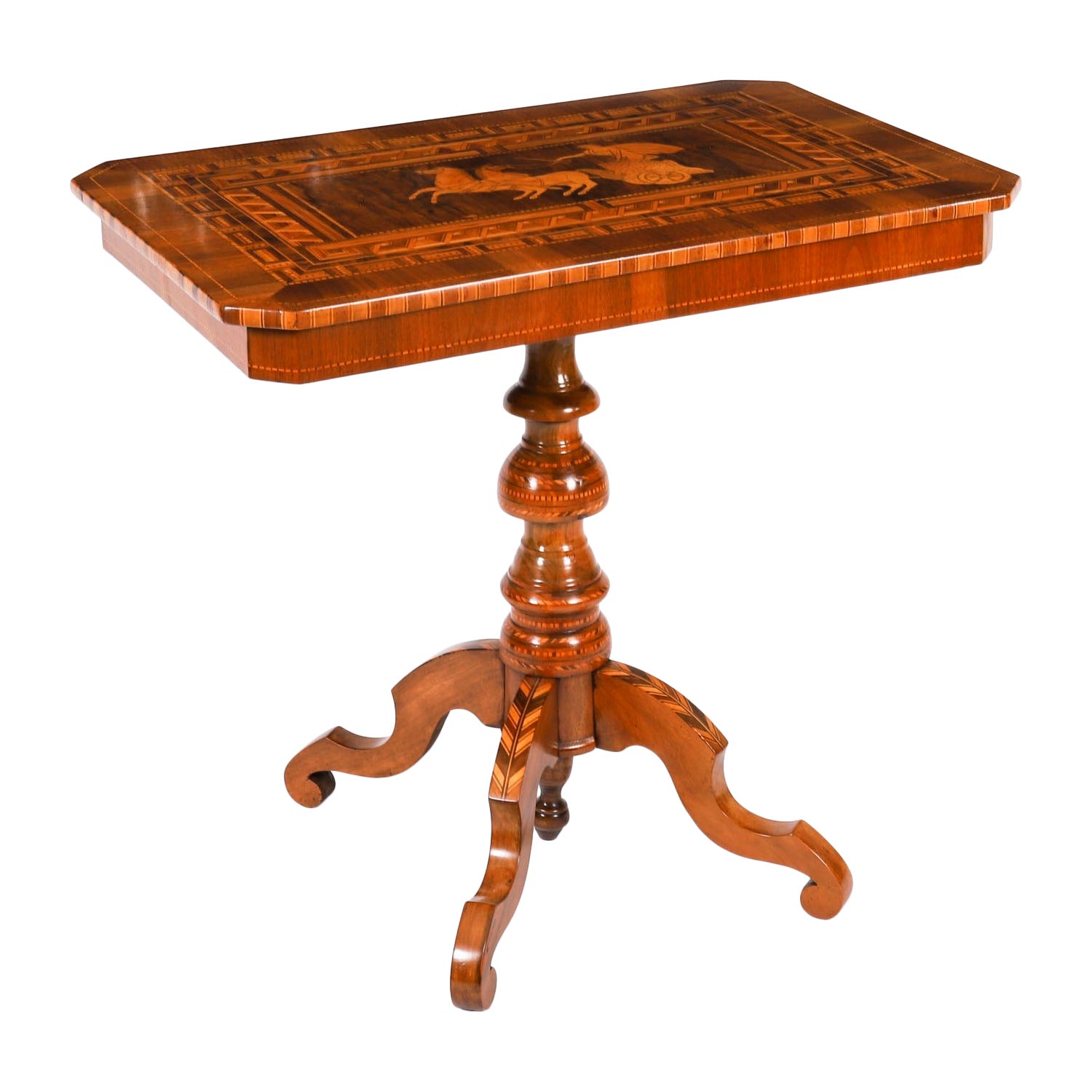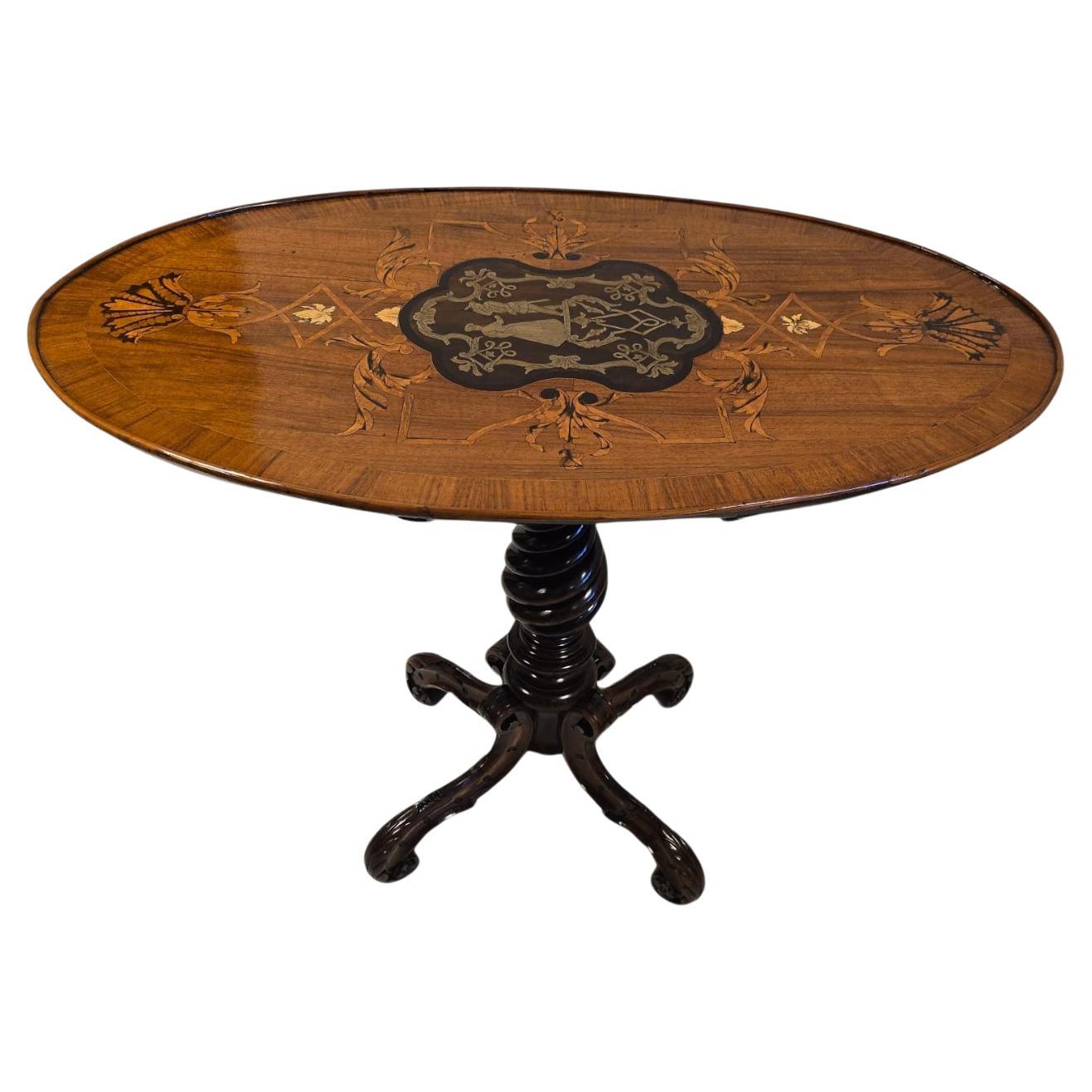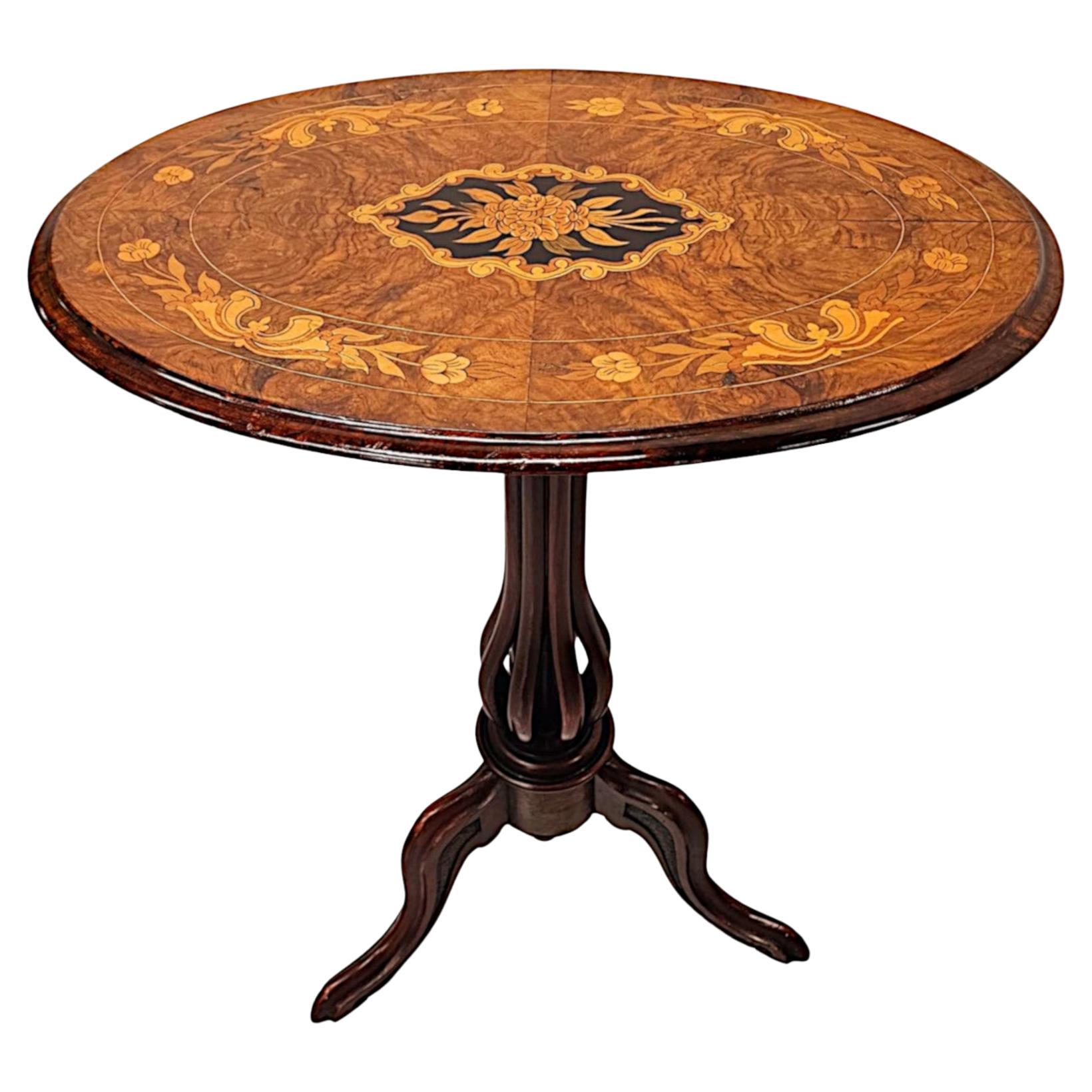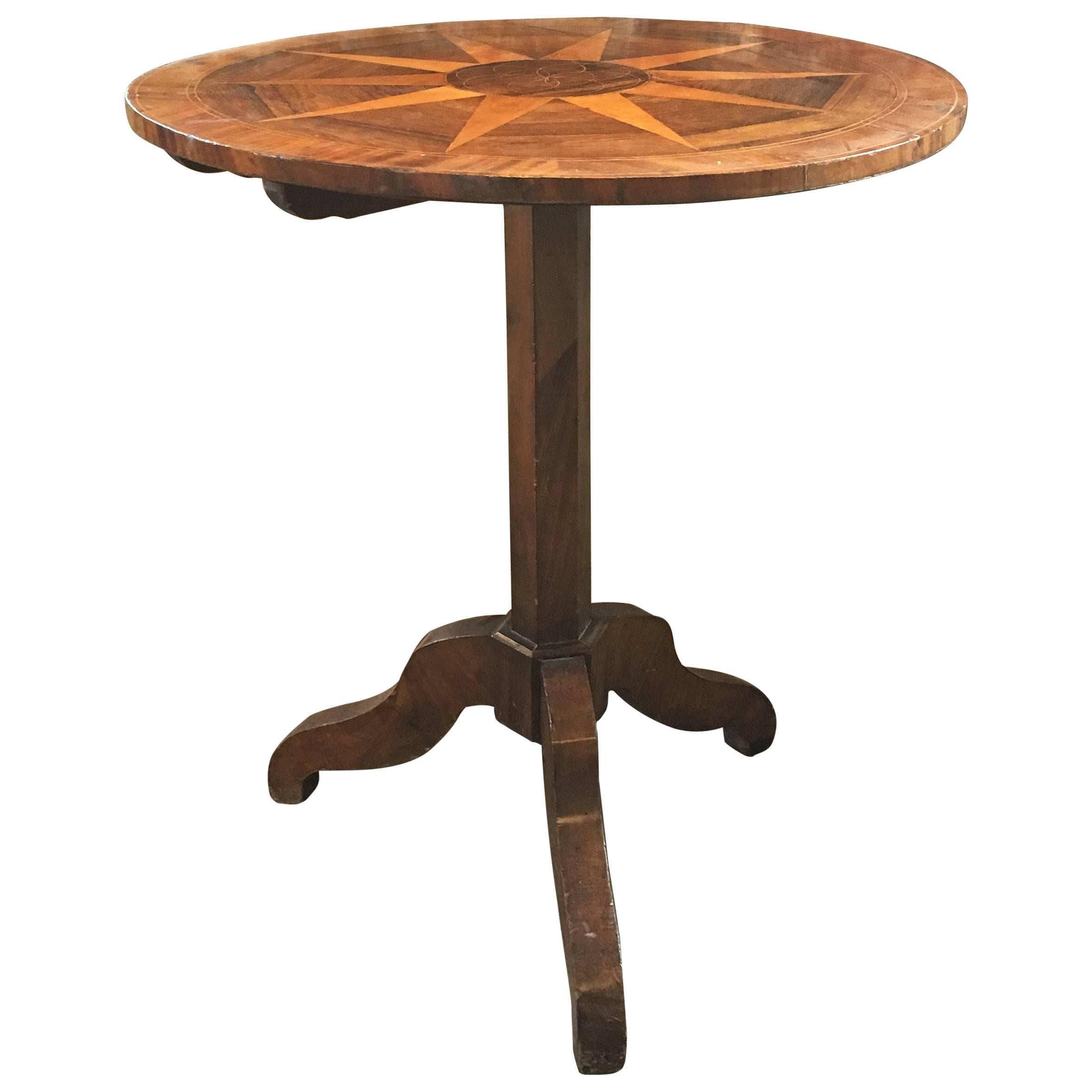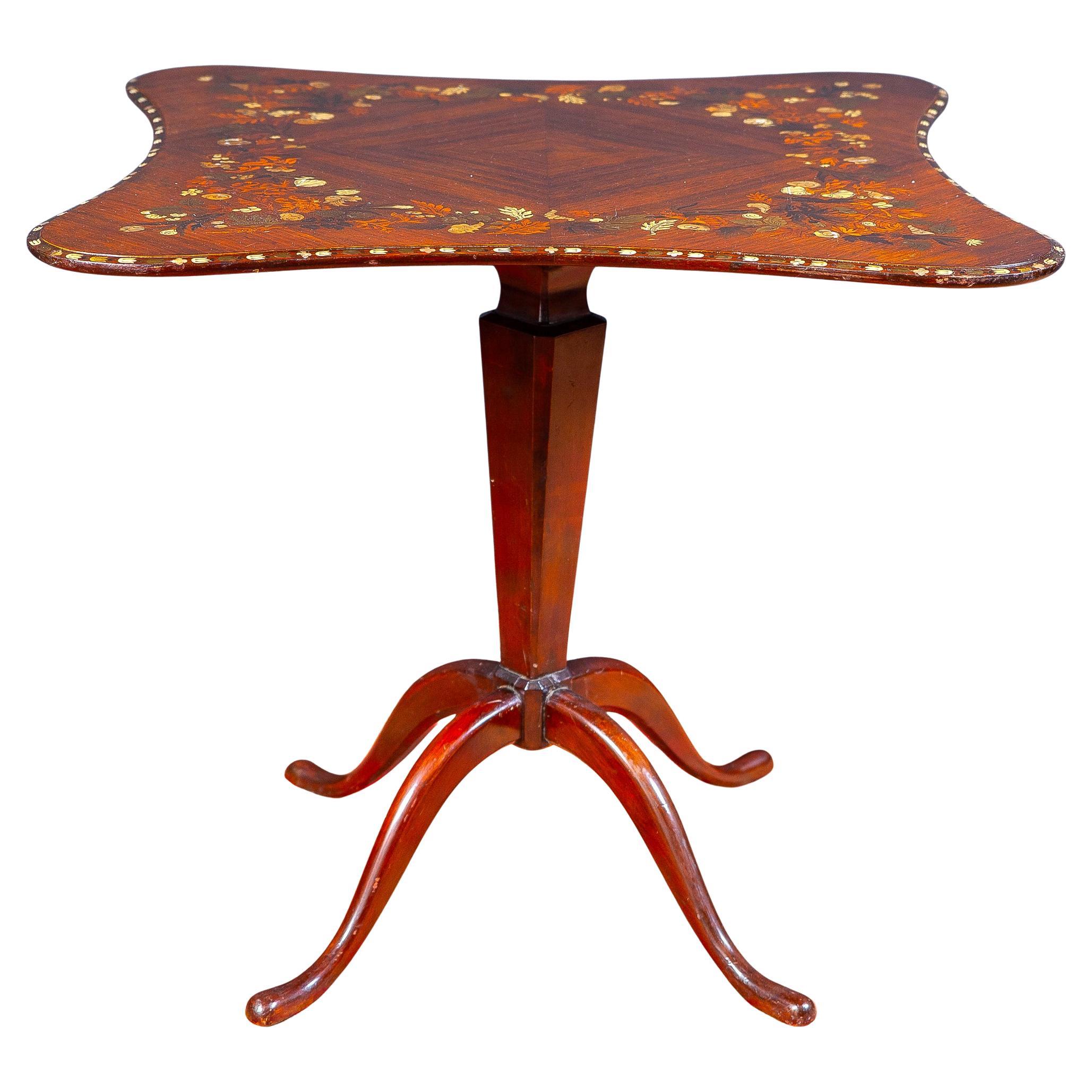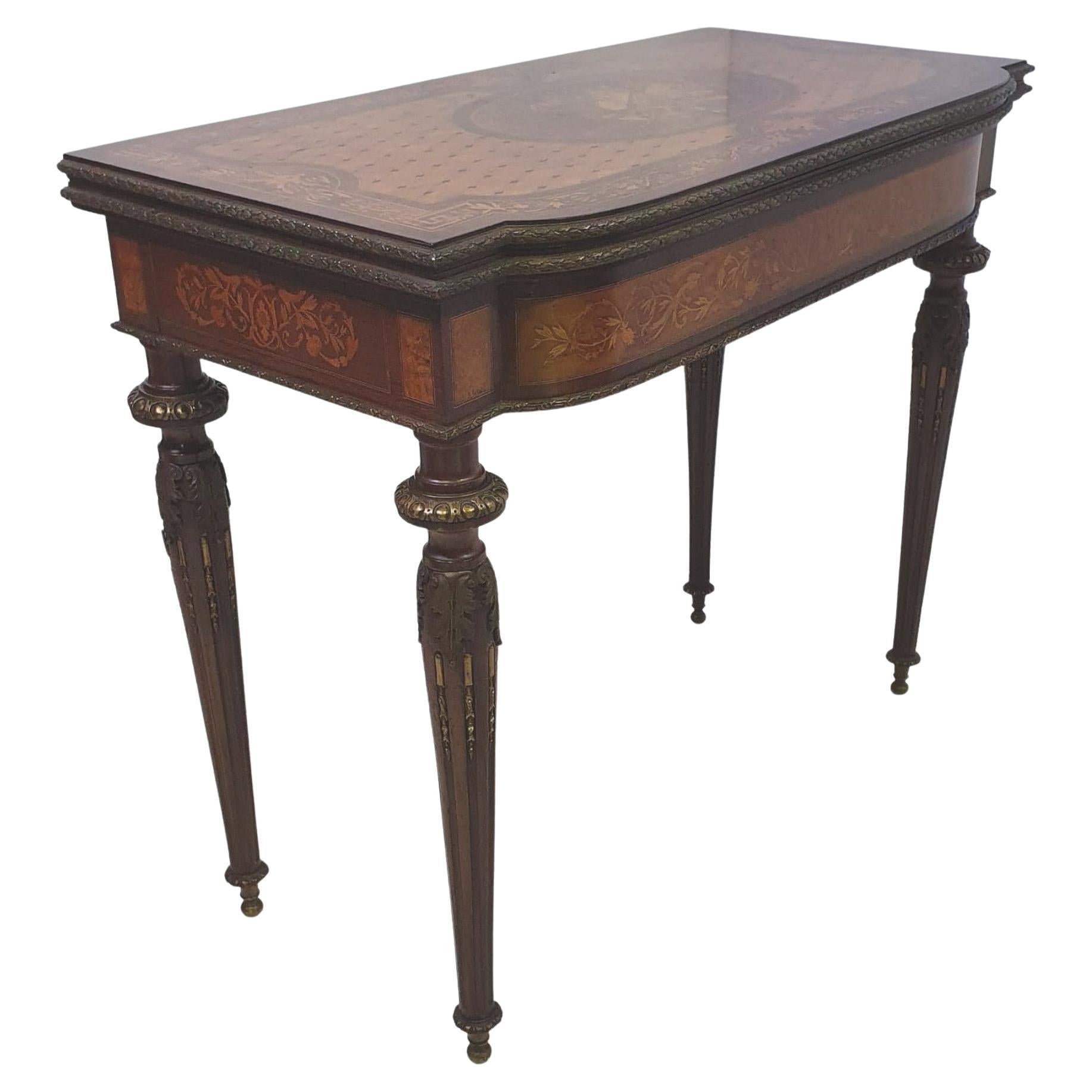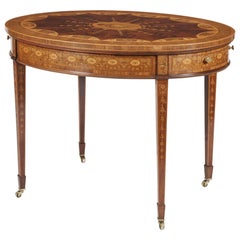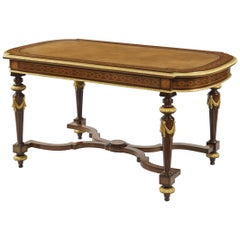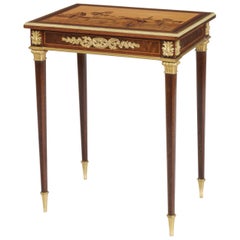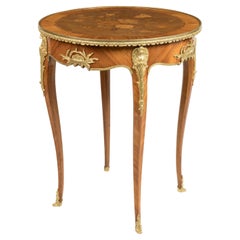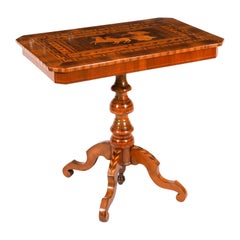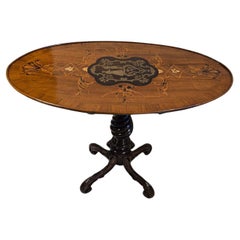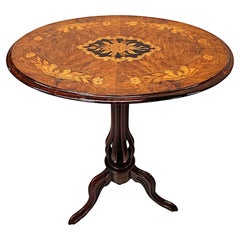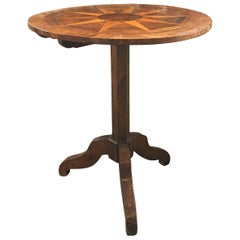Items Similar to An Unusual Marquetry Top Table Attributed to Jackson & Graham
Want more images or videos?
Request additional images or videos from the seller
1 of 7
An Unusual Marquetry Top Table Attributed to Jackson & Graham
$11,493.98
£8,500
€9,907.66
CA$16,128.06
A$17,587.36
CHF 9,239.10
MX$210,795.10
NOK 117,160.88
SEK 109,029.24
DKK 73,999.33
About the Item
An Unusual Marquetry Top Table
Attributed to Jackson & Graham
Likely Designed by Bruce James Talbert (1838-1881)
The circular top inlaid with a plethora of specimen woods and bone, consisting of an amboyna quadrangle ground set with geometric patterns of circles, triangles, and a diamond at the centre set with a geometric flower; the outer reserves on an ebony ground and set with further stylised foliate motifs; standing on its original mahogany fluted tripod base.
English, circa 1870
Dimensions: H: 29 in / 73.5 cm Dia: 16 in / 40.5 cm
It is worth comparing this table to the designs produced by Bruce James Talbert for the London cabinetmaker Jackson & Graham. Notably, a cabinet today in the Museum of Fine Arts in Boston by Jackson & Graham (acc. No. 1997.188) includes nearly identical inlaid motifs.
- Attributed to:Jackson & Graham (Cabinetmaker)
- Dimensions:Height: 29 in (73.66 cm)Diameter: 16 in (40.64 cm)
- Materials and Techniques:
- Place of Origin:
- Period:
- Date of Manufacture:circa 1870
- Condition:Repaired: Each item has undergone careful inspection and restoration by a conservation specialist in order to guarantee the original quality and integrity of the object. Wear consistent with age and use.
- Seller Location:London, GB
- Reference Number:Seller: 100901stDibs: LU954740484922
About the Seller
5.0
Recognized Seller
These prestigious sellers are industry leaders and represent the highest echelon for item quality and design.
Established in 1964
1stDibs seller since 2012
54 sales on 1stDibs
Typical response time: <1 hour
Associations
The British Antique Dealers' AssociationLAPADA - The Association of Arts & Antiques Dealers
- ShippingRetrieving quote...Shipping from: London, United Kingdom
- Return Policy
More From This Seller
View All19th Century Mahogany and Satinwood Astrological Marquetry Centre Table
By Maple & Co.
Located in London, GB
A fine quality astrological centre table
firmly attributed to Maple & Co
Constructed in very finely figured mahogany and satinwood, and having marquetry inlay of superior quality...
Category
Antique Late 19th Century English Victorian Center Tables
Materials
Mahogany, Satinwood
19th Century Marquetry Writing Table in the manner of Holland & Sons
Located in London, GB
A good writing table in the Manner of Holland & Sons
Constructed in mahogany, with specimen wood inlays, and gilt bronze mounts; of rectangular form, with bowed ends, rising from ri...
Category
Antique 19th Century British Victorian Desks and Writing Tables
Materials
Ormolu, Bronze
19th Century French Marquetry Side Table Depicting a Landscape of Specimen Woods
Located in London, GB
A fine quality side table
In the manner of Charles Topino
Of rectangular form, constructed in various specimen woods including thuya, walnut, boxwood, and yew, and having ormolu bro...
Category
Antique 1870s French Side Tables
Materials
Ormolu, Bronze
19th Century Marquetry Inlaid & Ormolu Table attributed to François Linke
By François Linke
Located in London, GB
A Very Fine Marquetry Inlaid Occasional Table
Firmly Attributed to François Linke
This fine table, closely related to other examples by François Linke, is...
Category
Early 20th Century French Side Tables
Materials
Ormolu
English Satinwood and Marquetry Centre Table by James Plucknett of Warwick
Located in London, GB
A fine Marquetry centre table by James Plucknett of Warwick
Of rectangular bow ended form, constructed in satinwood, and inlaid with specimen wood marquetry work on the platform; rising from toupie feet, the four finely carved caryatid female supports have a conjoined stylised 'X' form stretcher with a dished bowl at the centre; the apron housing a series of foliate carved entablatures, and the platform extensively inlaid with neoclassical designs of trophies, and floral arabesques. Bearing a label underneath the platform with the makers' name,
circa 1890.
James Plucknett, having had various partners in his company, operated as a sole trader from 1886-1905, the year of his death. He advertised his work as 'manufacturers of rich carved furniture', trading as 'James Plucknett & Co Art Furniture Manufacturers'. His commissions included The Royal Pavilion for the Royal Warwick...
Category
Antique 19th Century English Victorian Center Tables
Materials
Wood, Satinwood
19th Century Coromandel and Inlaid Table Attributed to Jackson & Graham
By Jackson & Graham
Located in London, GB
A magnificent library table
Attributed to Jackson & Graham
Of free standing rectangular form, constructed in coromandel, with inlays in thuya, ebony, boxwood, and honeysuckle; the fluted legs rising from square brass castor-shod feet; the frieze housing two lockable drawers fitted with rare ‘tamper proof’ Chubb locks and having quadrant moulded cedar lined interiors; the platform having a central panel of beautifully chosen matched coromandel veneers, with an outer guard border of a running pattern of stylised anthemions; the ebony edges having a thumb nail moulding,
circa 1865
The firm of Jackson & Graham established in 1836 by Thomas Jackson and Peter Graham at 37 Oxford Street London, and for the next fifty years produced predominately high quality furniture and represented Britain at many of the international exhibitions. Their clients included Queen Victoria, Napoleon III, the Grand Khedive of Cairo and the royal palace in Siam. They were particularly noted for their fine marquetry work, the use of Wedgwood plaques, rare woods, and fine casting of bronze mounts. They engaged the leading designers of the period, inter alia, Owen Jones, Bruce Talbert, Alfred Lorimer and Eugene Prignot. In the mid-1850s the workforce was recorded as 250, and by 1875, the company was employing 600 workers. They were feted exhibitors at many of the Great Exhibitions of the 19th century, and frequent prize winners. At the Paris International Exhibition of 1878, the furniture jury noted of them ‘ the workmanship is so perfect that even with the aid of a magnifying glass scarcely the slightest imperfection is to be found’. In 1885 the company was absorbed by Collinson and Lock, who continued their standard of excellence.
Charles Chubb was apprenticed as a blacksmith before starting business as a ships’ ironmonger in Winchester. Jeremiah soon joined the business, and by 1818 the brothers had branched out into lockmaking, founding the famous Chubb Company.
The business really got started when Jeremiah Chubb patented his new ‘detector lock’ in 1818. The lock was constructed so that if someone tried to pick it or open it with the wrong key it became inoperable. To make the lock work again the owner had to use a special key supplied with the lock. The aim of the detector lock was to prevent burglaries, and to warn the owner that someone had tried to break into their property.
The lock soon became popular, and sales of the Chubbs’ products increased even more when they won a government competition to design a lock that could only be opened using its own key. After the invention of the detector lock, the Chubbs decided to move to Wolverhampton, which already had an established lock making industry. By 1838 they were making 28,000 locks a year at their Wolverhampton factory. Another product was added to the Chubb range in 1835 when a patent was taken out for a burglar resistant safe, and in 1837 the Chubb safe...
Category
Antique 19th Century English Tables
Materials
Brass
You May Also Like
Antique Sorrento Italian Marquetry & Parquetry Occasional Table 19th Century
Located in London, GB
This is a beautiful antique occasional table, from Sorrento in Italy, c.1880 in date.
It was hand crafted from walnut and olive wood. The oblong top with canted corners is superbly...
Category
Antique 1880s Side Tables
Materials
Walnut
Elegant 19th-Century English Marquetry Table with Exotic Woods
Located in Madrid, ES
This refined 19th-century English table exemplifies the artistry of marquetry and craftsmanship from the Victorian era. Crafted with exotic woods and inlaid with pewter, it features ...
Category
Antique 1850s Center Tables
Materials
Fruitwood
19th Century Marquetry Inlaid Flip Top Occasional or Lamp table
Located in Dublin, IE
A very fine early 19th Century richly patinated marquetry and line inlaid burr walnut and mahogany flip top occasional or lamp table, finely hand carved, of exceptional quality and s...
Category
Antique 19th Century English Dessert Tables and Tilt-top Tables
Materials
Mahogany
Marquetry Side Table, circa 19th Century
Located in Napa, CA
Vintage hinged marquetry side table with star and elliptical motif. Hexagonal pedestal base with three legs.
Category
Antique 19th Century Side Tables
Materials
Wood
English Regency Marquetry Inlaid Center Table or Occasional Table, 1815
Located in Rome, IT
Elegant English Regency marquetry inlaid center table or occasional table with mahogany tripod base.
The tabletop with high quality inlaid decoration with various precious selected ...
Category
Antique Early 19th Century English Regency Center Tables
Materials
Wood
Rare 19th Century Museum Quality Marquetry Inlaid Card Table
Located in Dublin, IE
A rare museum quality 19th Century marquetry inlaid turn over leaf card table with ormolu mounts thoughout. The shaped and moulded top of rectangular form with intricate marquetry in...
Category
Antique 19th Century French Card Tables and Tea Tables
Materials
Ormolu
More Ways To Browse
Memphis Mimosa
Nebu Holland
Nicola Iron Side Table
Norman And Stacey
Oxford Side Table
Pagoda Style Side Tables
Paper Pulp Table
Pennsylvania House Maple
Pierre Chareau Fan Table
Piet Boon Klink
Prince Of Wales Table
Prismatic Table By Isamu Noguchi
Pulp Table
Queen Anne Kittinger Tea Table
Rattan Ghost
Resin And Rope Table
Roma Contemporary Side Table
Round Brass 3 Tier
